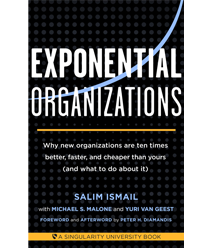
Discover 25 proven strategies any size organization or individual can use to accelerate innovation and growth with the low risk and high confidence certainty provides.
Technology-driven change is accelerating at an exponential rate, and organizations of all sizes are finding that reacting to problems and digital disruptions, no matter how agile you or your organization are, is no longer good enough. In addition, moving exponentially fast in the wrong direction will only get you into trouble faster!
The Anticipatory Organization, a powerful new book by leading futurist and New York Times bestselling author Daniel Burrus, now gives readers the ability to accelerate innovation and growth by learning how to anticipate disruptive problems and game-changing opportunities before they happen. It’s about developing the anticipatory mindset that will elevate your plans and the way you approach your business, your industry, and your customers to produce transformational results. In a world filled with uncertainty, it provides the confidence needed to make bold moves.
Inspired by the dramatic results organizations obtain from Burrus’ award-winning learning system of the same name, The Anticipatory Organization offers a comprehensive new way to pinpoint and act upon enormous untapped opportunities by identifying the forces that are shaping the future so a company or an individual business leader can plan accordingly.
You’ve heard the expression that the future holds only two certainties—death and taxes. Author Burrus, however, suggests the opposite. In The Anticipatory Organization, he shows his readers that the future is far more certain than we realize, and by learning his Anticipatory Skills such as the ones listed below, they can elevate their relevancy and impact in a world of transformational change:
- How to elevate planning by distinguishing Hard Trends that will happen, from Soft Trends that might happen;
- How to anticipate and pre-solve problems before you have them;
- How to use Hard Trend certainties to accelerate innovation and results;
- How to take your biggest problem—and skip it;
- How to turn disruption you thought was outside of your control, into innovations that you, yourself control.
Digital transformation has divided the world into two camps: the disruptor and the disrupted. The Anticipatory Organization gives readers the tools they need to make that choice, rather than waiting for others to make it for them.
Why didn’t a cab driver think of starting Uber, or Marriott think of Airbnb? Why did companies like Sony, Dell, Blackberry, Sears, to name only a few—who all knew how to be agile and execute strategy—rapidly fall behind? And what about small companies, entrepreneurs, and individuals who are blindsided by change and forced to close their doors or lose their jobs?
They all couldn’t react fast enough to the exponential rate of change. None of them knew how to anticipate and profit from change says the author. The ability to anticipate the future is a skill that can be learned. In today’s business landscape, it is the biggest missing competency.
With business and political uncertainty at global all-time highs, it’s imperative to learn to find the opportunity—where others see challenge and disruption. As the rate of change accelerates, uncertainty and disruption also accelerate. The importance of being able to anticipate disruptive problems and new opportunities will become increasingly important.
Says Burrus, “It’s true that you cannot predict everything, but you can accurately predict more than enough to elevate plans, accelerate innovation, and transform results.”
Daniel Burrus has been helping leaders to see and shape the future for over 30 years. The Anticipatory Organization synthesizes his proven strategies, which can be used by leaders and managers within an organization as well as entrepreneurs and individuals alike.

